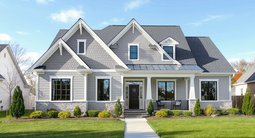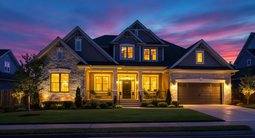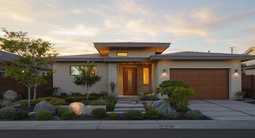TL;DR
Quick take: To choose exterior house colors for curb appeal, build a palette around your roof, stone, and landscape, then test large samples in real light. Use a visual tool like ReimagineHome.ai to upload a photo and trial palettes—neutrals for timeless resale, or character-rich greens, blues, and smoky charcoals for personality.
Why exterior color matters (and how AI can de-risk your decision)

AI tools help homeowners preview and select exterior colors that boost curb appeal effectively.
Exterior house colors are one of the fastest, most budget-friendly ways to change a home’s vibe and value. Recent homeowner surveys show roughly one in five households tackle an exterior paint refresh each year, often around a few thousand dollars, because curb appeal simply moves the needle when selling—or staying put. Here’s the thing: the exterior isn’t a blank canvas. Roof tones, brick, stone, stucco, paths, fences, even your front yard plantings all shape which palettes will sing. That’s where home design AI earns its keep. With a photo-to-home design workflow, ReimagineHome.ai lets you upload a snapshot, mask the siding, trim, and door, and preview two or three color stories side-by-side before you buy a single gallon. Searchers ask for room design ideas, but the same logic applies outside: pick a scheme, preview it like virtual staging, check it in morning and golden hour, then commit. The right mix can feel fresh yet timeless, play nicely with neighbors, and even lower cooling loads in hot regions.
The color-choosing game plan (step-by-step, with AI help)

Stepwise AI-assisted color planning lets homeowners visualize palettes before painting begins.
Direct answer: Shortlist colors that respect fixed elements (roof, brick, stone) and climate, then test on large boards; aim for a balanced LRV range—body 35–60, trim 70+, accent 5–25—for legible contrast. • Map your “fixed finishes.” Start with what won’t change soon: roof shingles, masonry, copper, and prominent landscaping. Pull two to three undertones you see repeatedly (warm taupe, cool gray, olive) and let those guide your palette. • Use LRV to balance contrast. Designers recommend Light Reflectance Value to steady the eye. As a rule of thumb, choose a main body between LRV 35–60 for depth without reading too dark, trim at LRV 70–85 to outline forms, and a front door/accent at LRV 5–25 for emphasis. Experts note that a 20+ LRV spread between body and trim keeps details crisp for most façades. • Consider climate and orientation. Light colors (LRV 60+) reflect more heat and can help keep surfaces cooler in hot, south- and west-facing exposures. Dark hues absorb heat and typically show fade sooner; factor this into maintenance cycles. • Decide your story: neutral, nature-driven, or bold. Neutrals like warm whites, soft greige, taupe, and blue-gray are still the safest bet for resale. Nature-forward greens (olive, sage, forest) and coastal blues (navy, slate) add personality without scaring buyers. In trend-forward neighborhoods, off-black or charcoal can look modern yet classic when paired with wood. • Test big, not tiny. Paint 24×36-inch boards with two coats of your top three candidates, move them around the façade for three days, and view at 10–15 feet in sun, shade, and overcast light. • Preview with AI before you paint. In ReimagineHome.ai, upload a clear, straight-on photo, use the masking tool to define siding/trim/door, and generate variations: - Timeless neutral set: creamy white body, warm white trim, slate door. - Nature blend: Mediterranean olive body, off-white trim, wood door. - Modern coastal: deep navy body, crisp white trim, brass hardware accents. Pair the façade with ai landscape design mockups—swap in drought-tolerant plant beds or a darker mulch—to see how greenery shifts color perception. User insight: Homeowners are moving away from stark black-and-white farmhouses toward softer, monochromatic palettes and greens that feel grounded; a colored door (teal, burgundy, or burnt orange) is a low-risk way to add personality.
Anecdote
A homeowner loved a jet-black mockup—until they viewed it at noon in midsummer. The AI preview turned the body almost mirror-hot. They shifted to a deep slate with creamy eaves, kept the drama, and cut heat gain noticeably on the west wall.
Common mistakes homeowners make (and easy fixes)

Avoid common exterior paint mistakes by considering light and fixed architectural elements early.
Avoid these pitfalls to save time and repaints: 1) Picking colors indoors. Exterior light is harsher and cooler; always test outside on large samples. Experts recommend viewing at three times of day and from the street. 2) Ignoring the roof. Roof color has the largest visual mass after siding. If it’s warm brown, a cool gray façade can look off; tie undertones together. 3) Too little—or too much—contrast. If body and trim are within 10 LRV points, details disappear. If they’re 40+ apart, the home can feel choppy. Aim for a 20–30 LRV spread for most styles. 4) Copying a trend without context. Off-black looks striking in cloudy coastal light but can overheat in full-sun desert climates. Let location lead. 5) Forgetting HOA or historic rules. Many districts specify approved color families. Confirm early, then preview compliant options in a home design AI to submit with your application.
Pro tips designers swear by

Design pros use the 60/30/10 rule for balanced and appealing exterior palettes.
Level up your exterior with these designer tactics: • The 60/30/10 rule still works. Use roughly 60% body color, 30% secondary (trim, soffits, garage), 10% accent (door, shutters). This keeps complex façades cohesive. • Sheen matters. Satin on siding adds cleanability; flat hides imperfections on old stucco; semi-gloss on doors and shutters sharpens edges. • Monochrome, done right. Paint trim 5–10 LRV lighter than the body for a sophisticated, tone-on-tone look that reads modern without losing definition. • Door drama, controlled. A saturated door works best when echoed once more—mailbox, planters, or house numbers—in the same family to feel intentional. • Plan for maintenance. In sunny climates, schedule darker hues for touch-ups every 3–5 years; lighter neutrals often stretch to 5–7 with gentle cleaning. • Use AI like an ai home decorator. In ReimagineHome.ai, save three shortlisted palettes, then export before/after visuals as a single PDF. Contractors bid faster when they can see exactly what you want. Citation-friendly tip: A 20–30 LRV spread between body and trim keeps architectural details legible from the sidewalk on most single-family homes.
Real stories, tools you can use, and a quick visualization

Real homeowners achieve stunning results using AI visualization and smart color choices.
Anecdotes & real stories • The resale flip: A seller swapped a tired tan for warm white (LRV ~82), added a navy door, and power-washed the walk. Their agent reported more showings the first weekend than the prior three weeks combined. • The climate check: A desert homeowner loved charcoal siding but previewed it in a room design AI workflow outdoors and saw it read almost black at noon. They pivoted to deep slate and cut surface temps noticeably on west walls. • The neighbor-friendly bold move: On a leafy street, a client chose olive with cream trim. A quick ReimagineHome.ai mockup eased the HOA review—approved on first pass. Tools, inspiration, and resources • ReimagineHome.ai: Upload a photo, mask zones, test palettes, and export shareable mockups. Try ai yard design add-ons to coordinate planting beds and hardscape colors. • Paint calculators and LRV charts: Confirm coverage and contrast before you buy. • Color readers: Handheld devices help translate your roof or stone undertone into usable paint matches. • Image SEO helpers for your project gallery: Suggested alt text—“exterior house colors olive green with cream trim,” “bright white modern farmhouse siding and black shutters.” Visualization (imagine this): You stand at the curb at golden hour. The body is soft sage, trim a warm off-white, the cedar door glows. The garden’s layered greens echo the façade, and the whole elevation reads calm, confident, complete—exactly like the mockup you approved.
Visualization Scenario
Picture your façade at twilight: body in Mediterranean olive (LRV ~36), trim in warm white (LRV ~78), a wood door, and uplights grazing columns. The lawn reads richer against the olive, and the walkway draws the eye to a front door that now feels like an invitation.
FAQ: Your exterior color questions, answered
Q1: How should I choose exterior house colors with AI if I’m overwhelmed by options? A: Start with your fixed elements (roof, brick, stone). In ReimagineHome.ai, upload a photo, mask siding/trim/door, and test three palettes: neutral, nature-inspired, and bold. Keep a 20–30 LRV spread between body and trim for clear contrast. Q2: What LRV is best for exterior paint in a sunny, hot climate? A: Aim for lighter bodies (LRV 60–85) to reflect heat, pair with mid-tone trim, and keep accents darker for depth. Experts recommend avoiding very dark bodies on west-facing elevations in extreme sun due to faster fade. Q3: Should my trim match or contrast the siding? A: Both work. For a classic look, choose trim 20–30 LRV points lighter than the body. For a modern monochrome, keep trim within 5–10 LRV points of the body so details remain visible without high contrast. Q4: Do dark exterior colors fade faster than light ones? A: Yes. Dark, low-LRV colors absorb more UV and heat, typically showing fade sooner. If you love depth, consider deep slate or green-black instead of pure black, and plan on more frequent maintenance. Q5: What exterior colors increase home value the most? A: Warm whites, soft greige, taupe, and blue-gray remain the broadest crowd-pleasers. If you want character, add it at the front door—teal, burgundy, or brass-accented black—since doors are easy to refresh before listing.
Bring it home: a palette you’ll love for years
Exterior color isn’t about chasing trends; it’s about honoring what’s already there—your roof, masonry, light—and choosing a palette with enough contrast to celebrate shape. Test big, preview smart, and let your climate steer gloss and tone. When in doubt, neutrals and nature-derived hues are hard to beat for value and longevity. Ready to see it before you paint it? Upload a photo to ReimagineHome.ai and spin up two or three palettes you’ll be happy to live with—and proud to list—anytime.
.svg)

.svg)














.png)